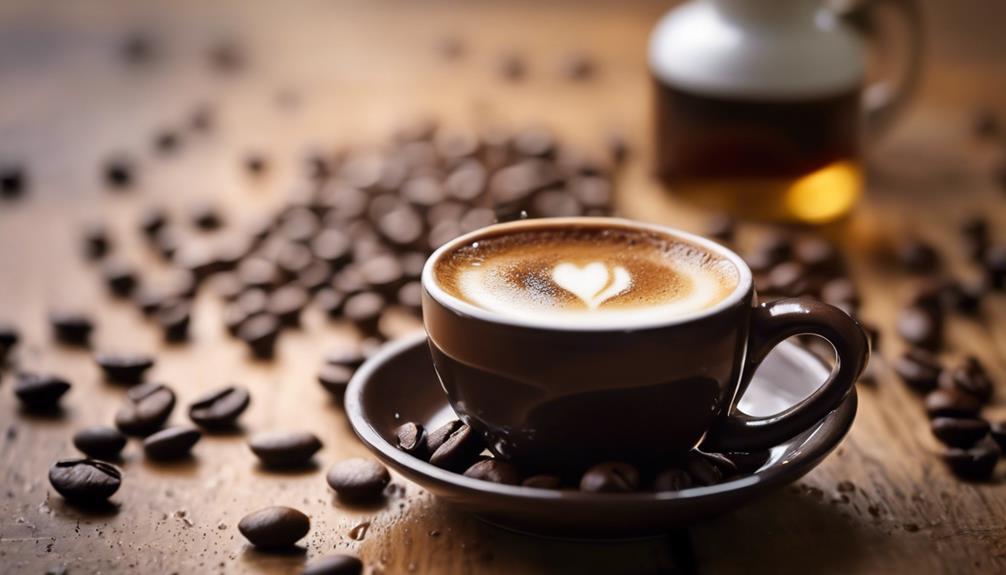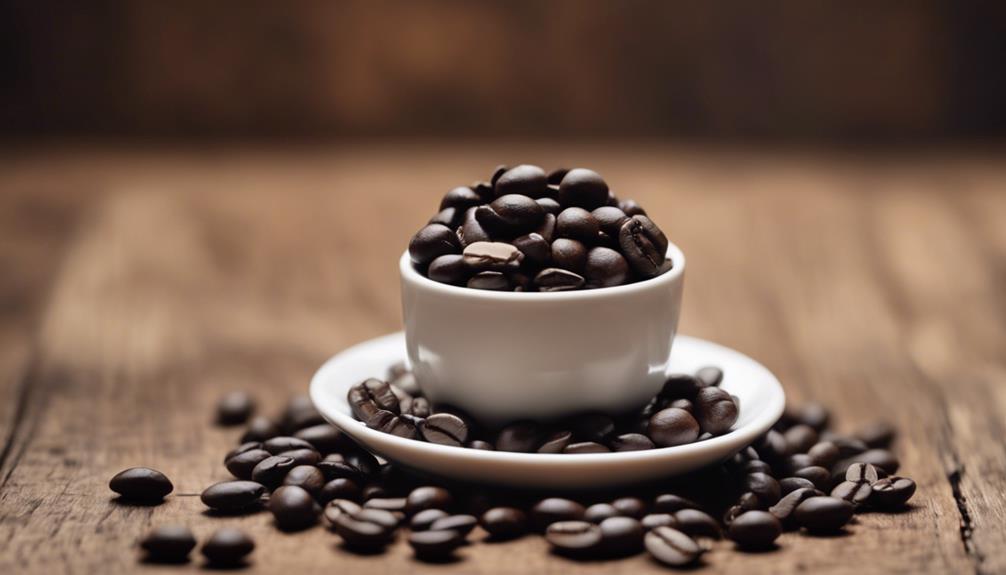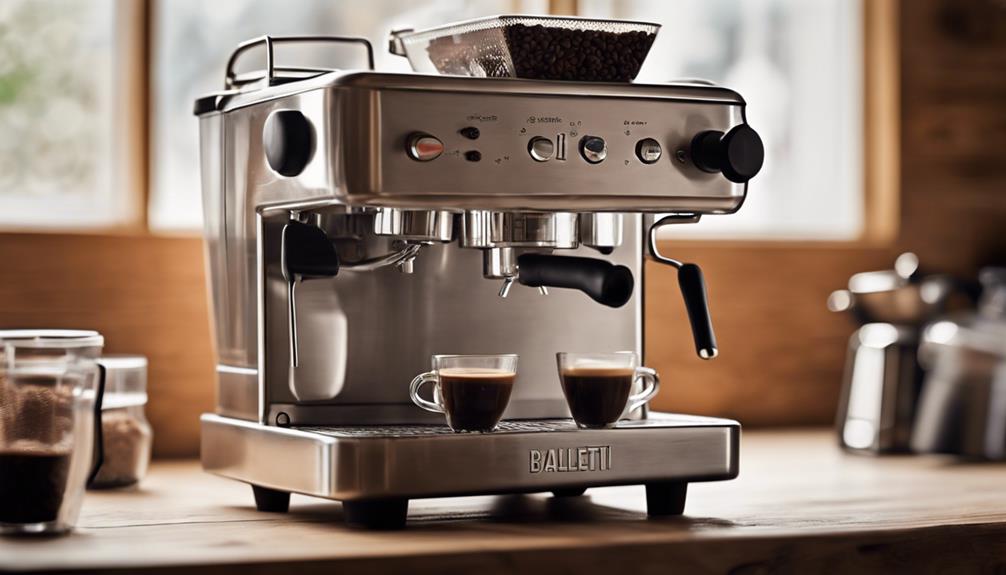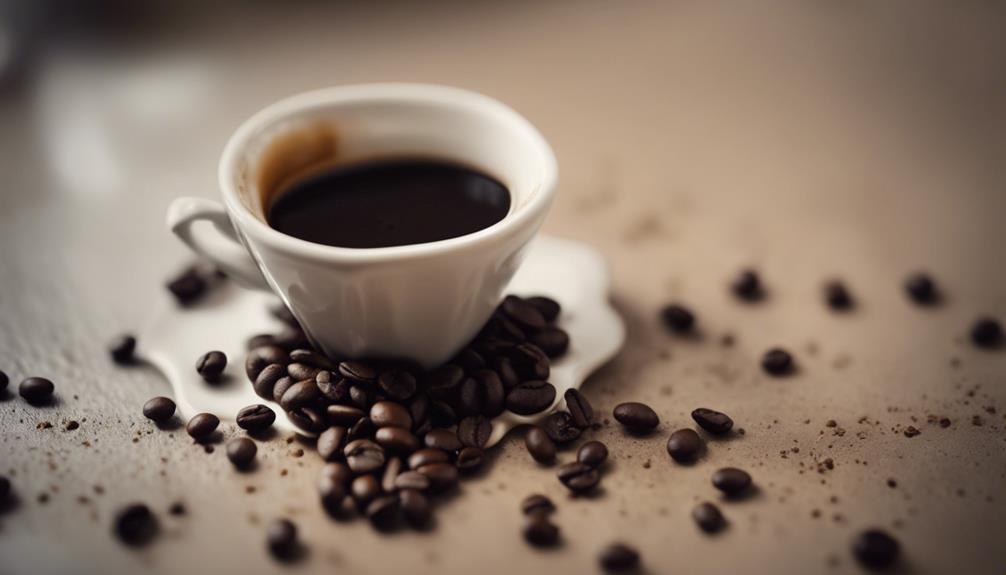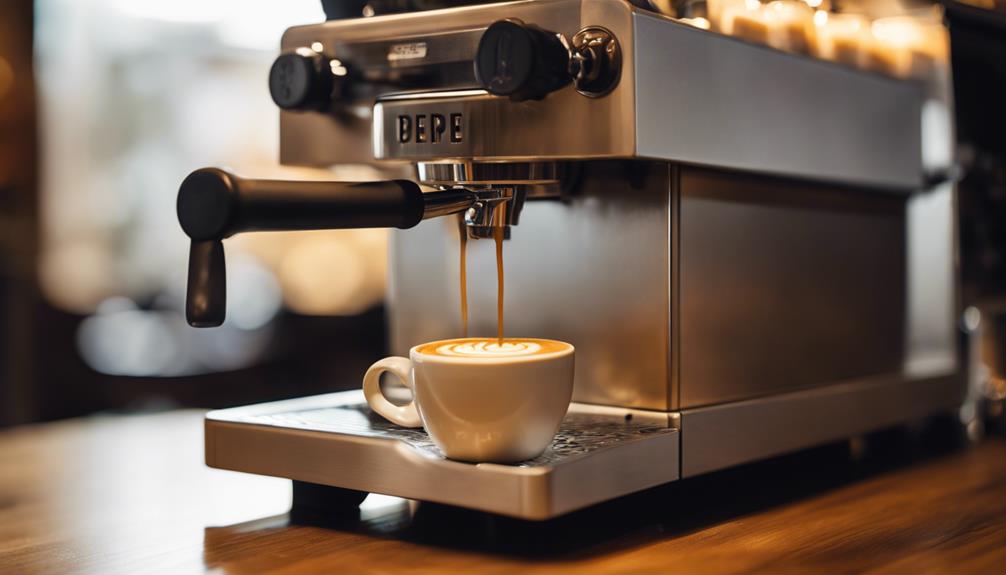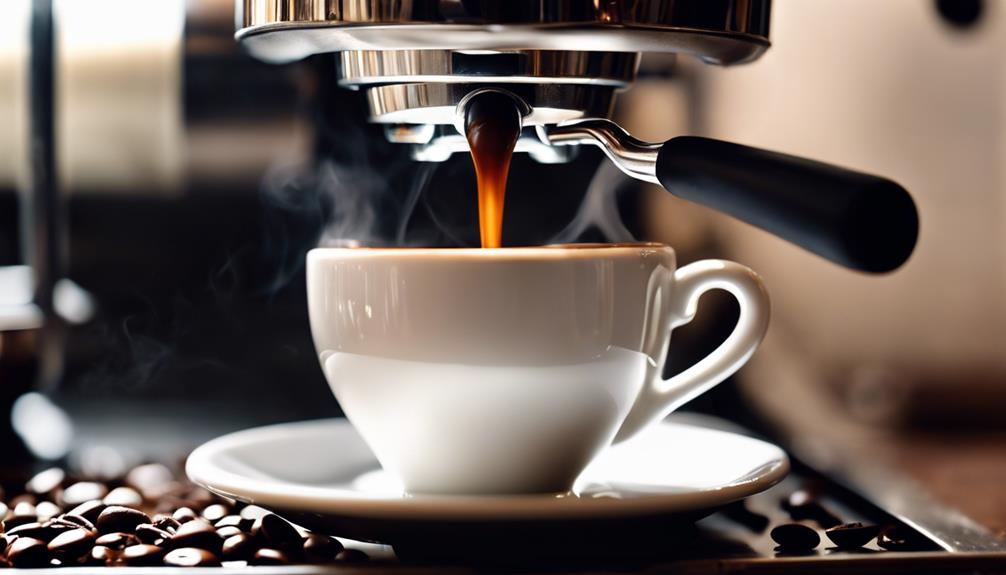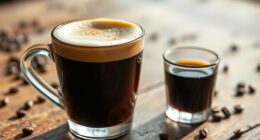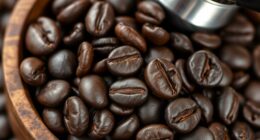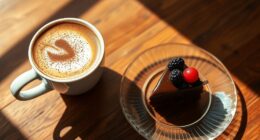As you dive into the world of espresso, you will experience a robust flavor profile topped with a layer of crema, typically containing 60-100mg of caffeine in a 1-2 ounce serving. Achieving the perfect shot requires nearly boiling water, high pressure, and optimal conditions, such as maintaining a water temperature between 194°F to 201°F. Various roast levels and bean choices can result in distinct flavors, ranging from intense and bold to vibrant and fruity. Whether you are an avid coffee enthusiast or just beginning your journey, get ready to unlock the secrets to creating exceptional espresso – with even more discoveries awaiting as you delve further into this dynamic world.
Key Takeaways
- Espresso is a concentrated coffee beverage made by forcing pressurized hot water through finely ground coffee beans.
- The ideal brewing temperature for espresso is between 194°F and 201°F, which yields a rich flavor with a layer of crema on top.
- A typical serving of espresso contains 60-100mg of caffeine, with a flavor profile that is bold and rich, making it a base for popular drinks.
- High-quality espresso beans are typically dark roasted and freshly ground, with Arabica and Robusta being popular options due to their unique flavor profiles.
Understanding Espresso Basics
As you explore the world of espresso, understanding the fundamental principles behind this beloved brewing method is essential to appreciating its rich flavor profile and versatility in coffee preparation.
At its core, espresso is a brewing method that uses near-boiling water and high pressure to extract flavors from finely ground coffee beans, resulting in a rich, bold taste with a layer of crema on top. Crafting the perfect espresso also relies on the quality and blend of the coffee beans used. Coffee bean selection plays a pivotal role in determining the flavor profile and complexity of the espresso. The right combination of beans can offer a harmonious balance of acidity, sweetness, and bitterness, resulting in a well-rounded and satisfying cup of espresso.
When you take a shot of espresso, you're experiencing the culmination of precise brewing conditions, including water temperature, ideally between 194°F to 201°F, and brewing pressure, maintained at around 9 bars. This perfect balance yields a concentrated beverage with approximately 60-100mg of caffeine per 1-2 ounce serving.
The quality of espresso is heavily influenced by the type of beans used, so it's no surprise that espresso serves as the base for various popular coffee drinks, including lattes, cappuccinos, and americanos.
Espresso Blends and Quality
As you explore the world of espresso, you'll notice that the quality of your shot heavily relies on the type of beans used and how they're roasted.
You'll want to look for beans that meet specific criteria, such as high-quality robusta beans, to guarantee a rich flavor profile.
Bean Selection Criteria
When it comes to crafting the perfect espresso, you need to carefully evaluate the type of coffee beans you're using, as the quality of your beans will directly impact the flavor of your final product. Dark roasts and high-quality robusta beans are often preferred for their rich flavor profiles and higher caffeine content.
However, the quality of the beans goes beyond just the type. Roasters carefully select and prepare beans based on their intended use for espresso, weighing factors such as acidity levels, roast quality, and flavor notes.
Here are some key factors to evaluate when selecting beans for espresso:
- Freshness of the beans: Using beans within two weeks of roasting is ideal for peak crema quality and flavor profile.
- Flavor profiles: Rich flavor profiles can be achieved with dark roasts and high-quality robusta beans.
- Acidity levels: Espresso blends can vary in acidity depending on the type of beans used and roast levels.
Roast Level Importance
You've carefully selected your coffee beans, but now it's time to think about the roast level, which greatly impacts the flavor profile of your espresso, with darker roasts typically producing a richer, bolder taste and enhanced sweetness. The roast level of your coffee beans markedly influences the flavor profile of your espresso, making it an essential consideration when crafting the perfect shot.
| Roast Level | Acidity | Flavor Profile |
|---|---|---|
| Light Roast | High | Bright, fruity notes |
| Medium Roast | Balanced | Nuanced, chocolatey notes |
| Dark Roast | Low | Rich, bold, and sweet |
| Espresso Roast | Low | Intense, smoky notes |
| Specialty Roast | Varies | Unique, complex flavors |
When selecting a roast level, roasters consider the intended use of the espresso, aiming to balance flavors that can stand up to milk or shine on their own in straight shots. The quality of the beans and their roast level are essential for achieving the desirable characteristics of espresso. Remember, poor roasting can lead to burnt or bitter flavors that detract from the overall experience. By choosing the right roast level for your coffee beans, you'll be well on your way to crafting exceptional espresso blends that showcase the rich taste and complexity of high-quality beans.
Caffeine Content and Effects
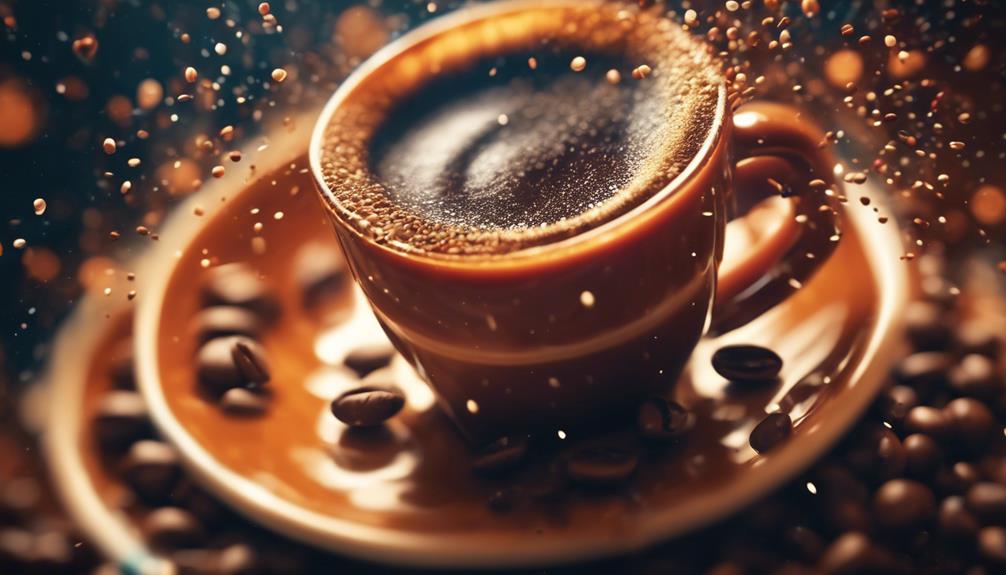
As you enjoy your espresso, you're probably wondering about the caffeine kick you're getting.
You'll be interested to know that a single shot of espresso packs a significant amount of caffeine, which can give you a much-needed energy boost.
But it's important to be mindful of your caffeine intake, as excessive consumption can have negative effects.
Caffeine Boost
With its concentrated serving size, a single shot of espresso packs a potent caffeine punch, delivering approximately 60-100mg of caffeine in just 1.5 fluid ounces.
As a coffee lover, you're probably wondering what sets espresso apart from regular coffee. The answer lies in its brewing method and coffee grounds. Espresso's unique brewing process extracts a higher amount of caffeine from the coffee grounds, making it a more concentrated source of energy.
Here are some key facts to keep in mind:
- Espresso has about 42mg of caffeine per fluid ounce, nearly four times the caffeine concentration of regular drip coffee.
- Despite its smaller serving size, a standard 8-ounce cup of drip coffee can sometimes contain more caffeine overall than a single shot of espresso, depending on the brewing method and bean type.
- The perfect espresso typically comprises 60-70% of caffeine extracted from the coffee grounds during a 30-second brew.
Caffeine Limits
By the time you're halfway through your daily routine, you've likely consumed a significant amount of caffeine, and it's essential to understand the limits to avoid overdoing it.
When it comes to espresso, a single shot contains around 60-100mg of caffeine, which is about 25-30% of the recommended daily limit of 400mg for adults.
To put that into perspective, espresso has almost four times the caffeine content of regular coffee, with a whopping 42mg per ounce compared to 11.5mg in regular coffee.
The type of coffee bean used also affects the caffeine content, with Robusta beans containing about twice the caffeine of Arabica beans.
While a shot of espresso has a lower total caffeine amount than an 8-ounce cup of coffee, the concentration of caffeine is higher due to its smaller serving size.
Regular consumption of 3-4 shots of espresso typically keeps caffeine intake within safe limits for most adults, considering the average caffeine content of other common beverages.
Enjoying and Making Espresso
To truly experience the rich flavors and aromas of espresso, you'll want to savor it in small sips, allowing each complex note to unfold. This allows you to appreciate the intricate flavors and aromas, often served without milk or sweeteners alongside a glass of water as a palate cleanser.
To make quality espresso at home, you'll need the right tools and techniques. Here are some key considerations:
- Invest in an espresso machine or a Moka pot to guarantee peak extraction.
- Use very fine coffee grounds and adjust the grind size based on your taste preferences.
- Maintain a water temperature between 194°F to 201°F for ideal brewing.
Espresso-Based Drinks and Variations
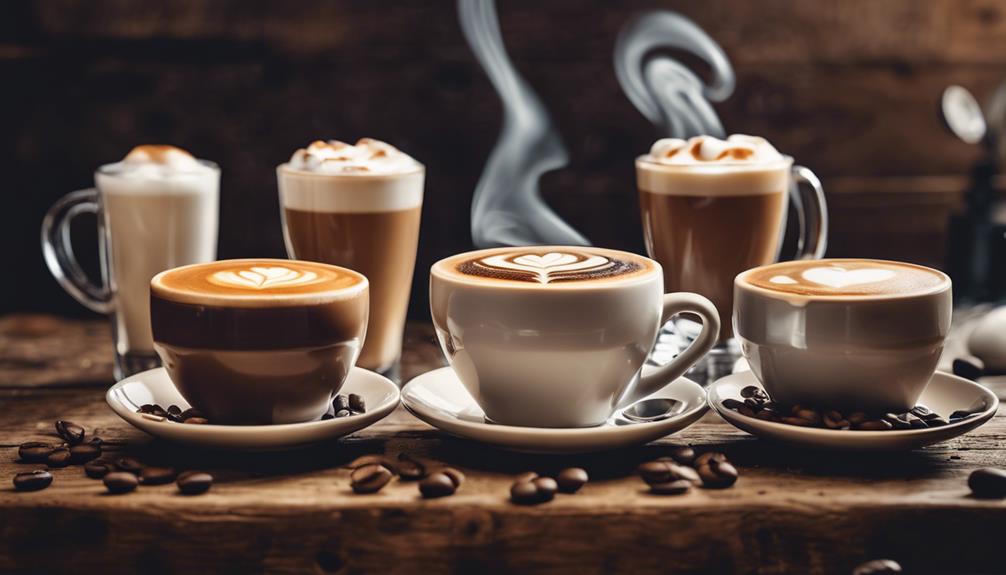
You can expand your coffee repertoire by exploring the diverse range of espresso-based drinks and variations that have been crafted around this concentrated coffee shot.
From classic drinks like Caffé Latte, which combines espresso with steamed milk, to Cappuccino, featuring espresso topped with equal parts steamed milk and milk foam, there's a world of flavors to discover.
If you prefer a milder taste, an Americano is made by diluting a shot of espresso with hot water, resulting in a similar strength to drip coffee but with a different flavor profile.
For a bold experience, try a Macchiato, where a small amount of steamed milk or foam 'stains' the espresso, highlighting its rich flavor.
You can also venture into mixology with espresso-based cocktails like the Espresso Martini, blending espresso with vodka and coffee liqueur.
Experiment with variations like Ristretto, a shorter, more concentrated shot, and Lungo, which results in a longer extraction and a milder flavor profile.
With so many options, you're sure to find your perfect cup.
Coffee Consumption Trends and Innovations
As consumers increasingly seek unique flavor experiences and prioritize convenience, coffee consumption trends are shifting towards innovative and high-quality brewing methods, with espresso at the forefront of this revolution. You're likely to notice that more people are opting for low-acid coffee options, which is why espresso's unique taste profile is gaining popularity. Home brewing methods, including espresso and cold brew, are also on the rise as you prioritize convenience and quality.
Some key trends driving the coffee industry forward include:
- The growing demand for specialty coffee and artisanal blends, which emphasizes unique flavor experiences
- The rise of espresso-based beverages, such as lattes and cappuccinos, as you explore diverse coffee options
- The increasing popularity of cold brew espresso, which combines the bold flavor of espresso with the smoothness of cold brew
Espresso Equipment and Accessories
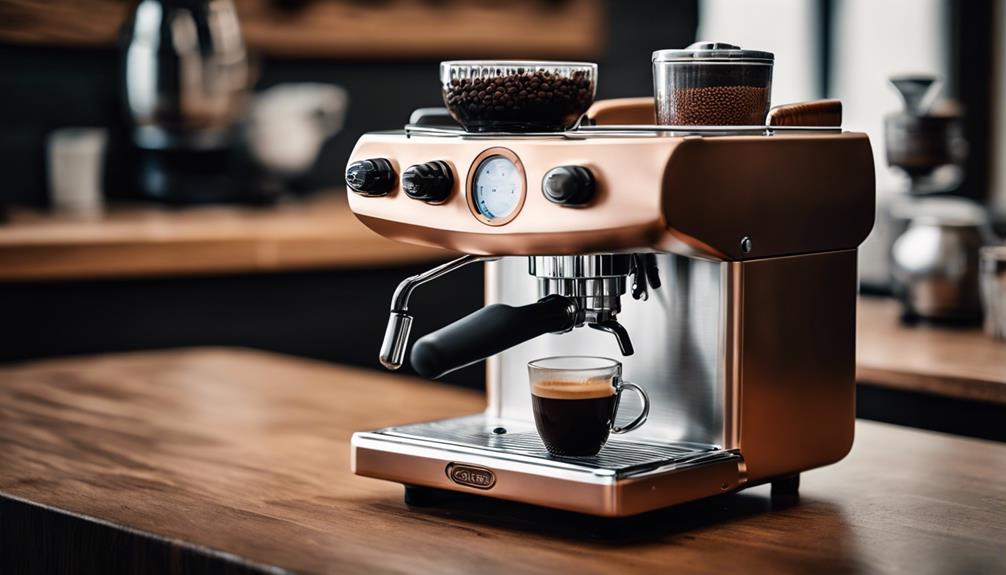
Your espresso journey begins with the right equipment, and that means investing in a few essential tools that'll help you craft the perfect shot.
First, you'll need a reliable burr grinder to produce consistent coffee grounds. Next, a portafilter will hold those grounds during extraction, and a tamper will guarantee they're evenly compacted for ideal brewing.
When it comes to espresso machines, you'll find manual, semi-automatic, and automatic options. As a home brewer, a semi-automatic machine offers the perfect balance of control and convenience.
Don't forget a knock box to efficiently dispose of used coffee pucks, keeping your workspace clean and maintenance easy.
Remember, maintaining the correct brewing temperature, around 200°F, is vital for achieving the best extraction results and flavor profile.
Finally, regularly clean your tools, including the portafilter and steam wand, to prevent flavor degradation and maintain the longevity of your espresso machine.
With these essentials, you'll be well on your way to crafting exceptional espresso shots.
Brewing and Extraction Techniques
With your equipment in place, it's time to master the brewing and extraction techniques that reveal the full flavor potential of your carefully selected coffee beans.
Brewing espresso involves forcing hot water, ideally between 194°F to 201°F, through finely ground coffee under pressure, typically around 9 bars (130 psi). This results in a concentrated extraction.
To achieve the perfect shot, consider the following key factors:
- Grind size matters: A very fine grind increases the surface area of the coffee, allowing for optimal extraction in the recommended brew time of 25-30 seconds.
- Even tamping is essential: Tamping the coffee grounds evenly in the portafilter creates a uniform coffee bed, guaranteeing consistent extraction and preventing channeling during brewing.
- Pre-infusion enhances uniformity: Briefly saturating the coffee grounds with hot water before the full extraction can improve overall flavor and balance.
Frequently Asked Questions
What Do You Need to Know About Espresso?
When it comes to espresso, you need to know it's a concentrated shot of coffee made by forcing hot water through finely ground beans, and its quality depends on beans, grind, and brewing technique. One of the key factors in making a successful espresso is the brewing technique, as this can affect the flavor and strength of the final product. Some people may also be interested in the ristretto vs espresso differences, as ristretto is a shorter and more concentrated shot made with the same amount of ground coffee but half the amount of water. Understanding these differences can help coffee enthusiasts appreciate and perfect their espresso-making skills.
What Are the 4 Qualities of Espresso?
Oh, you thought you knew espresso? Ha! You're just scratching the surface. The 4 qualities you need to master are crema, body, heart, and aroma – and trust me, you're not even close to getting it right… yet!
What Are the Golden Rules of Espresso?
You're looking for the golden rules of espresso! To brew a perfect shot, you'll want to use freshly roasted beans, grind them fine, and maintain ideal temps and brew times, all while ensuring proper tamping and equipment maintenance.
How Is Espresso Different From Coffee?
You're about to uncover the secrets that set espresso apart from coffee – and it's not just about the buzz. You'll find a richer, more concentrated flavor in espresso, thanks to its unique brewing method and finer grind.
Conclusion
You've reached the final shot of this espresso journey!
As you now hold the knowledge of this rich and complex beverage, imagine yourself as a master barista, expertly crafting each cup like a work of art.
Your newfound understanding is the spark that ignites the perfect blend, and with every sip, you'll savor the flavor of a passion that's been brewing all along.
